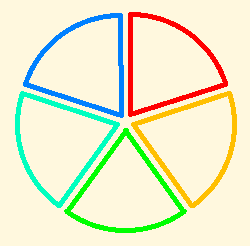What is a Unit?
On Tuesday in class we discussed how one whole unit doesn't necessarily have to be "one."
For instance:
If you eat 1 and 1/2 grapefruits every morning and you have a total of 5 grapefruits and you want to know how many days they will last, you wouldn't find the answer to this problem by dividing 5 by 1. Instead you would find the answer by dividing 5 by 1 and 1/2 since that is the whole unit you are working with.
 | |||
| 1 and 1/2 grapefruits |
This skill is applicable when you are shown part of a picture and told it's a fraction of a whole...
For instance:
If you're told this is 3/4 of the whole, what would the whole be?
 | |||||
| 3/4 of the whole |
This would be the whole: (not at scale)
Next we discussed a basic understanding of fractions and how important it is to explain them to kids correctly. Most of us were taught that if you see a fraction such as 3/5 you should think of it as 3 out of 5. Which is all fine until you get to a fraction like 4/3 which will completely confuse a child because they can't conceptually understand that from the 4 out of 3 explanation.
This is how you should instead explain it:
3/5 should instead be explained as Three 1/5 pieces. That way when you get to fractions such as 4/3 you can explain it as Four 1/3 pieces. This method easier for children to comprehend and unlike the simplistic way is actually something they can apply to more difficult problems as they progress in school.
 | |||
| Three 1/5 pieces would be three of the above sections... |
Big Ideas: Partitioning and Iterating
Partitioning: Splitting the whole into equal parts.
 |
| So if you're told the above rectangle is a whole unit and to find 1/4 you would "partition" it into 4 equal pieces |
| (Image not to scale) your result would be something like this, with the unshaded piece representing 1/4 |
 | |||||||||
| So if you were told the above triangle is 1/3 and you were to find a whole unit you would iterate the triangle three times. |
 | |||||||
| (not to scale) You can see how 3 triangles iterated results in a trapezoid shape. |
Thursday March 28th~
Saying Fractions:
We reviewed as discussed above how to properly say fractions, for maximum comprehension, (3/4 would be three 1/4 pieces)
We then discussed the definition of numerator and denominator:
Numerator: The NUMBER of pieces.
Denominator: The DENOMINATION (size) of the pieces.
For the rest of the class period we did activities that discussed whole units and fractions and their meaning.
Hope this post was helpful! :)


Of the few blogs I have read so far, yours is by far the most helpful. You did a great job going through step by step and explaining how a whole unit does not have to equal one. Using many detailed pictures on your blog helped me visualize what you were explaining. Overall I would say you did a great job!
ReplyDeleteMelody, I think you have a good start to your blog. It covered everything from lecture in way that was fresh but also made sense. My only consideration to your blog so far is incorporating pictures that match or are cohesive with your blog. For example your pictures in your partitioning section, although they did succeed in explaining your idea, were hard to connect since they were different size and shape. I would encourage you to use paint on your computer to make your pictures its easier and you don't have to cite! Keep up the good work.
ReplyDeleteYou have the most thorough blog in the class. You did a good job of breaking down each different concept and had a great usage of various pictures. I can tell a lot of time and effort was put into this project!
ReplyDeleteI really like the pictures that were used to help explain each way to represent the subtracting and adding the different fractions. I also like the fact that you used examples for each one. I was a little confused on the difference between partitioning and iterating fractions in class but the example explained it really well.
ReplyDelete